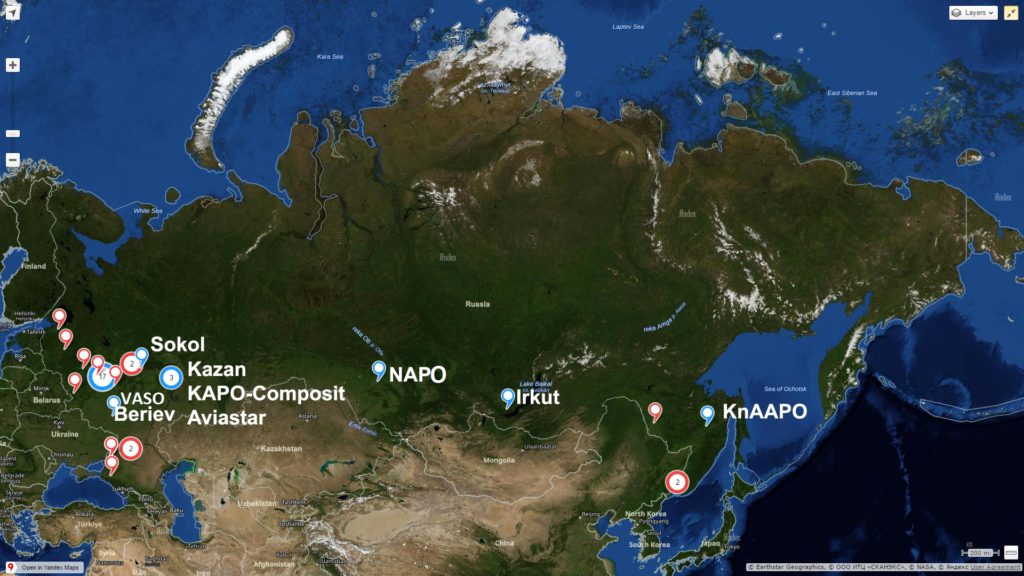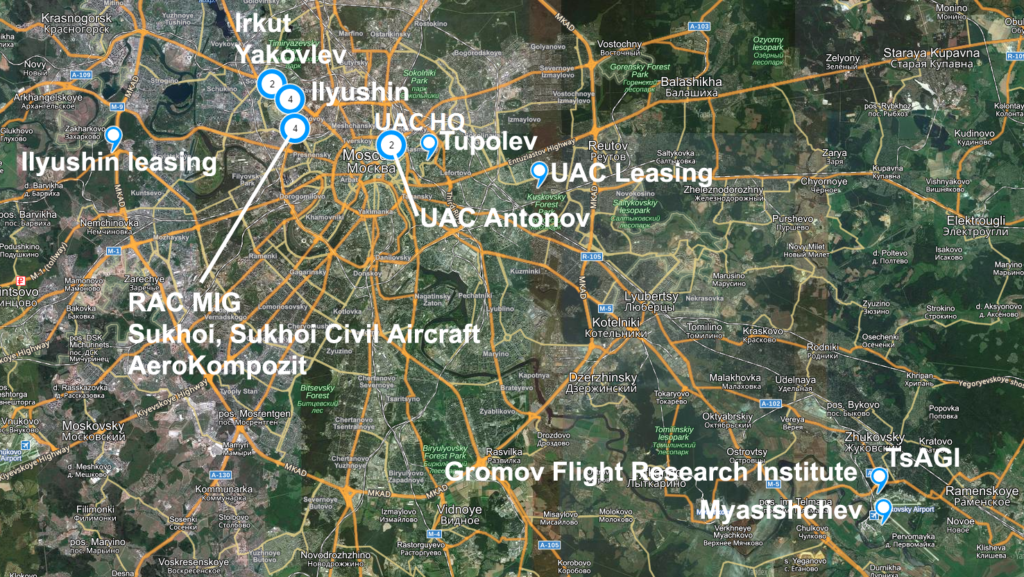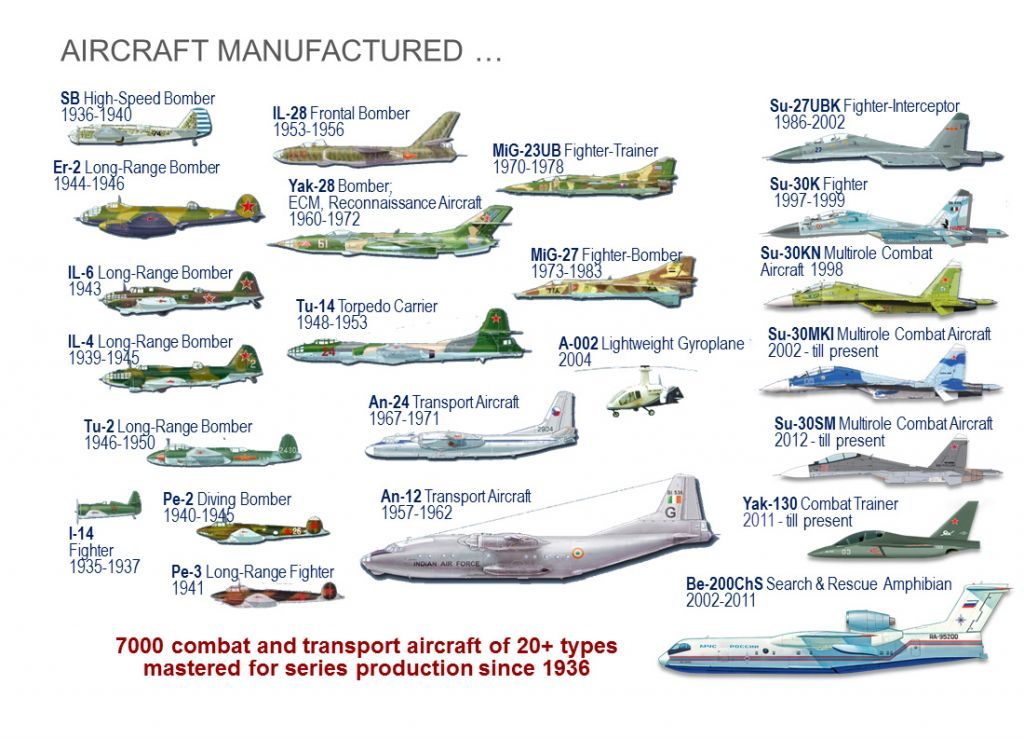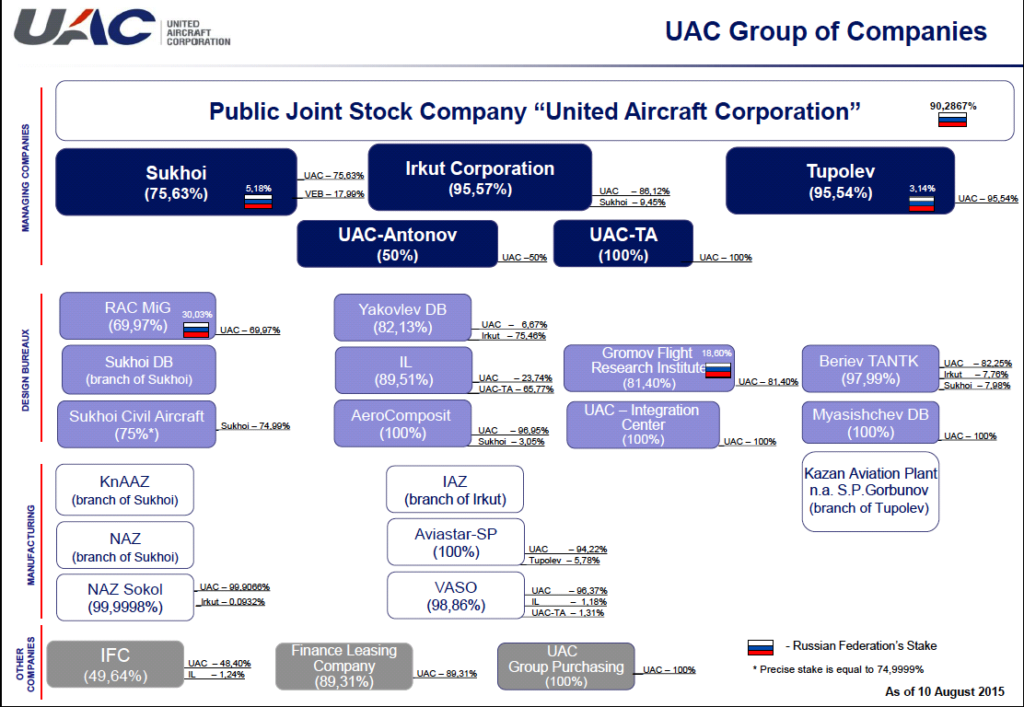Leeham News and Analysis
There's more to real news than a news release.
Bjorn’s Corner; The Russian civil aircraft companies
 September 16, 2016, ©. Leeham Co: In our Corners on East bloc aeronautical industries, we will now look at the main Russian civil aircraft companies. There is one overall company since 2006, United Aircraft Corporation (UAC).
September 16, 2016, ©. Leeham Co: In our Corners on East bloc aeronautical industries, we will now look at the main Russian civil aircraft companies. There is one overall company since 2006, United Aircraft Corporation (UAC).
This is a state-owned holding which incorporates 30 of the main companies from the Soviet times, employing 100,000 people. The aim is to coordinate and optimize Russia’s project and production resources around the present aircraft and the future projects that Russia can afford to drive.

Figure 1. Map of UAC Companies in Russia outside of Moscow region. Red markers are MRO. Source: UAC.
UAC consolidates several company groups that were formed after the fall of the Soviet Union 1990 and up to the formation of UAC in February 2006.
We will now dissect the main UAC groups and companies that are involved in civil aircraft development and production.
Sukhoi group
As described in the last Corner, one of the company groups that managed the time after 1990 better than others was the Sukhoi group. Sukhoi was a design bureau but was expanded after 1990 into a vertically integrated group by including KnAAPO (Komsomolsk-On-Amur manufacturing company) and NAPO (Novosibirsk Aircraft Plant) in the group, Figure 1.
Headquarter and design bureau is in NW Moscow, Figure 2, where also the Sukhoi Civil Aircraft company is placed. Sukhoi is developer of the regional SSJ100. Final assembly of SSJ100 is at KnAAPO in the far East, Figure 1, with parts production at several plants in Russia, among them NAPO. Around 26,000 people work in the Sukhoi group.
Irkut
Irkut group was the other company that fared reasonably well in the post Soviet era. It was vertically integrated when the Irkut manufacturing company (Figure 1) incorporated the Yakovlev design bureau 2004 (NW Moscow, Figure 2).
The aircraft that has been produced by the manufacturing company is shown in Figure 3. It shows that very few designs were made by its present design competence, the Yakovlev design bureau. Only the recent YAK-130 military jet trainer was developed by Yakovlev.
The large project for the group is now the MC-21 single aisle airliner where Irkut is program leader and houses the Final Assembly Line. The group has around 14,000 employees.
Ilyushin
The third grouping which designs and produces civil transport aircraft (the IL-96 wide-body aircraft) in UAC is the Ilyushin group. Headquarters and design bureau is in NW Moscow (Figure 2). Production of the Ilyushin IL-96 is done at VASO (Voronezh Aircraft Production Association, Figure 1) which had Ilyushin as major shareholder (shares now transferred to UAC). The companies employs around 14,000 people.
The present product runner is the IL-76 transporter in various forms, it is produced by Aviastar (Figure 1). Ilyushin’s major future civil project is leading the Russian-Chinese wide-body program.
Tupolev
Tupolev was the major design bureau for airliners in the Soviet Union (Tu-104, Tu-124, Tu-154). Today, the only produced Tupolev airliner is the Tu-204/214 “Boeing 757” class airliner, which is produced in small numbers by Tupolev’s own manufacturing arm, Kazan (Tu-214 made by Kazan Aviation Plant, KAPO, Figure 1) and by Aviastar (Figure 1), which makes the Tu-204 variant. Tupolev and Kazan employs around 15,000 people.
Tupolev now concentrates on strategic bombers and is progressively leaving the civil airliner field.
United Aircraft Corporation
The the gathering of all these companies was made by forming the state owned United Aircraft Corporation (UAC) February 2006. The initial role is to coordinate the activities of all the above companies and to create one unified way forward.
Today a very small part of the UAC turnover is civil airliners. Goal is to increase the civil airliner activities so that they constitute 50% of group turnover by 2025. UAC is also creating corporate functions that can gradually unify the activities of the different parts of the group, Figure 4.
This makes sense. Airlines which inducts the groups aircraft don’t want to talk to three different organizations when they operate the SSJ100, MC-21 and the future wide-body. The UAC ownership structure for the different companies is shown in Figure 5.






Thank you Bjorn for this very nice article!
We in the West often have no idea how the Russian industries work and what they are capable of. We are too fixated on Airbus, Boeing, GE, RR, CFM and PW to the exclusion of everyone else. It is remarkable that after collapsing completely when Soviet Union fell, Russian aircraft industry has had a rebirth in the form of UAC, which is now able to tackle the technologically and logistically complex task of making technically advanced aircraft such as the SSJ and MC-21 that approach western standards, if not meet and exceed them. This is good news for Russian aircraft industry, given the dire situation it finds itself in. It is not that it did not produce excellent engines and aircraft in the past, but it did lag quite a bit in modern material and manufacturing technology. It appears to have caught up somewhat. MC-21 is a good example, with improvements beyond Airbus and Boeing narrow bodies, such as a wider fuselage, wider middle seat, wider aisle, modern glass cockpit with side stick controls incorporating feedback (which Airbus has not implemented even after the AF 447 disaster) etc. PD-14 is a good design, approaching the TSFC of comparable western engines, if the published value of 0.52 is any indication. Would you kindly publish the cruise TSFC you derived for PD-14 from your proprietary model?
Can you do what you did for Irkut for the Sukhoi, Ilushyn and Tupolev branches (and whatever is left of Antonov) to show what aircraft they have handled in the past? That would be useful.
Here is an Ilyushin one, but it’s in Russian
https://pbs.twimg.com/media/CeayKSvXIAAwoQl.jpg:large
And one for Su-27 and a dazzling number of derivatives that I just had to link because it so well done
http://www.deviantart.com/art/Family-84038761
and another…
https://img.ifcdn.com/images/0dfc33f9c2ddf9fd1020510bf4e1c82c33cb5b632df75db7a9ed27ec001b5eb8_1.jpg
And two adorable kittens…
http://www.deviantart.com/art/Family-84038761
Love the kittens…
Hi Kant,
Irkut had the good taste to make this nice graphic of what aircraft they have produced and put it on its web site. I can’t find anything similar on the others sites. Re PD-14, it’s a good step forward. I have modeled it using GasTurb (Gasturb.de, we don’t have own software for engines) and found that 0.52 probably is a bit optimistic, around 0.54 seems more likely but that is not bad at all.
Thanks Bjorn. I am familiar with GasTurb, a nice software package, essentially gas turbine cycle analysis with excellent graphics interface. However, the results depend on the input parameters, and this is where one needs insight and information that is often not easily found in open literature.
Hmmm… 0.54 is not too bad, given the steep curve they had to climb. If they can offer it at low prices, which compensate for the somewhat higher fuel costs, given its other advantages, MC-21 might succeed in the market. However, world-wide after-sale support is crucial and this is where Russians still lag far behind.
Ilyushin,not Ilushyn! My bad.
Keep in mind for all these aircraft, there is a constant refrain from the people that buy them about technical support and parts lacking.
the Chinese also followed that pattern of a State Owned and directed company and we go the C919. Keep in mind I believe it was Bjorn that posted that the Chinese left the exhibit and wnet off to play.
The MC-21 looks to be a good hand built aircraft. It also has major Western content.
Its when it comes to industrializing the build process and the tech support and parts support that it will fail on.
Rolling all those entities into one organization and expect it to work is impossible under good circumstances and with all the political and government involvement it will never work.
It took Airbus 40 years(?) to finally shuck most of its heritage and even now that is still a work in progress. They had a far easier path as Boeing chose not to compete with them and that is no longer true.
They will be diverted on the next project on the wide body Chinese/Russian project. That should be a real muck up to see.
I feel you are right on that. Its really just transferring the old Soviet era Ministry of Aviation Industry into a western style corporate structure which still had the largely independently run design bureaus, construction plants and repair plants grouped together. As the Brits found when they forced mergers of their aviation business culture clashes and just different ways of doing things let to costly delays
What Russia needs is their own modern-day Howard Hughes [LOL]
And a good five dollar ceegar! (LOL)
Putin would arrest him.
I hope people do not take the remarks wrong.
I feel deeply sorry for the Russian people. Never allowed to progress into the modern world.
It does not bode at all well for their attempts to venture forth and most of their military sales have been serous problematical for any support, let alone effective.
Being an avid reader of AV week I was aware of what Bjorn has put forth, far better to have formed a couple of independent entities and let them compete.
That does not work in with the attitude of total control.
Any independence is quashed.
It was really tragic they missed such a golden opportunity in the 90s to become a democracy.
I suspect Putin’s grip isn’t as strong as he would like, if it was he would have strong-armed the production side into one group. The diverse design groups might be a strength, in that competing one against the other should produce strength from competition, assuming they have enough resources to do the job.
Ilyushin at Voronezh employs 10K people and some monkeys and bears in the factory zoo…
Thanks Javier, it was hard to get that figure. I have Ilyushin themselves as 3,800 would you know if that is correct as well. Also hard to find.